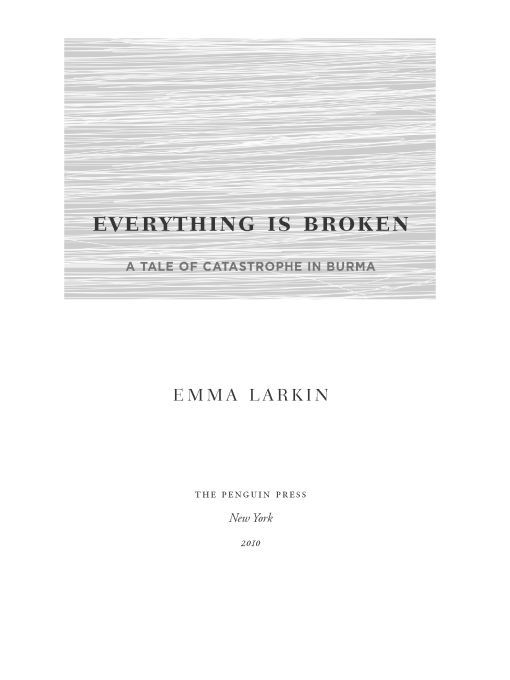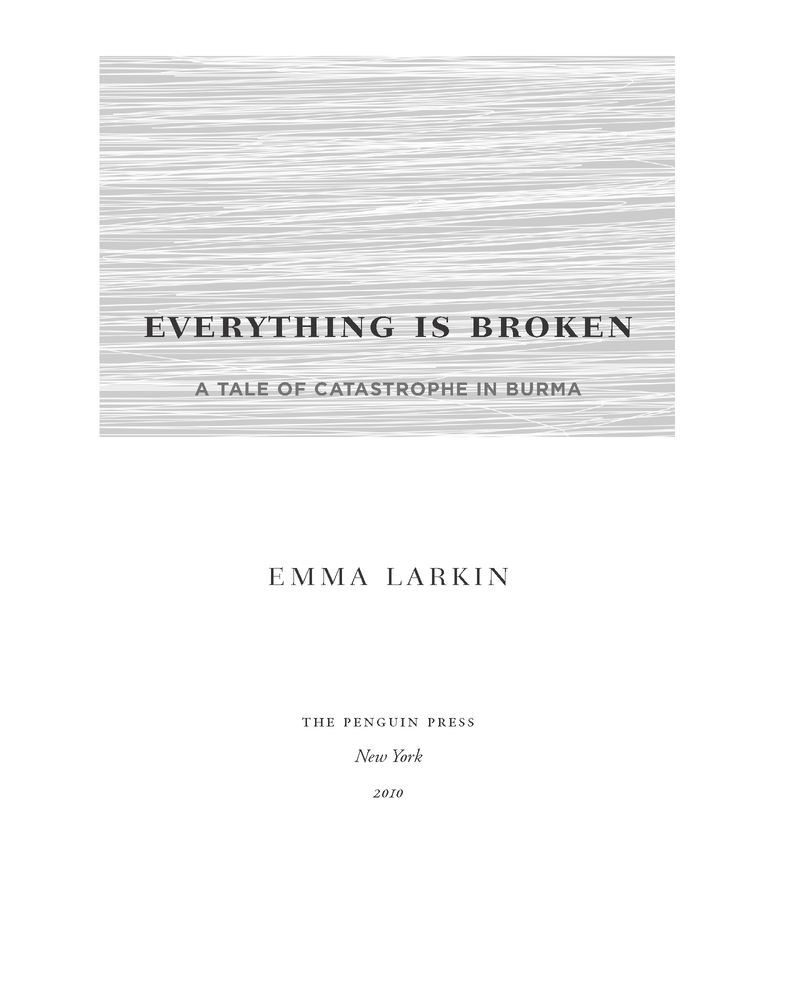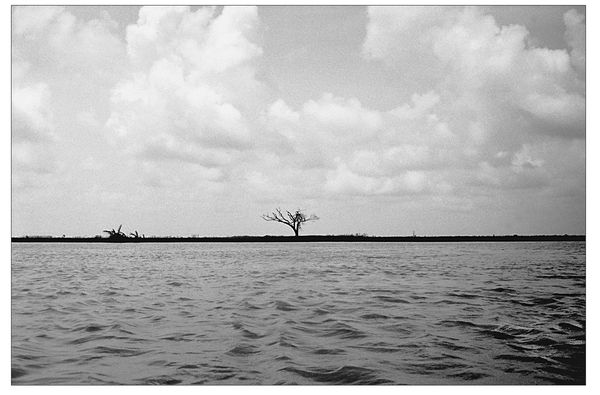Everything Is Broken
Read Everything Is Broken Online
Authors: Emma Larkin


Table of Contents
ALSO BY EMMA LARKIN
Finding George Orwell in Burma

THE PENGUIN PRESS
Published by the Penguin Group
Penguin Group (USA) Inc., 375 Hudson Street, New York, New York 10014, U.S.A. • Penguin
Group (Canada), 90 Eglinton Avenue East, Suite 700, Toronto, Ontario, Canada M4P 2Y3
(a division of Pearson Penguin Canada Inc.) • Penguin Books Ltd, 80 Strand, London WC2R
0RL, England • Penguin Ireland, 25 St. Stephen’s Green, Dublin 2, Ireland (a division of Penguin
Books Ltd) • Penguin Books Australia Ltd, 250 Camberwell Road, Camberwell, Victoria 3124,
Australia (a division of Pearson Australia Group Pty Ltd) • Penguin Books India Pvt Ltd,
11 Community Centre, Panchsheel Park, New Delhi - 110 017, India • Penguin Group (NZ),
67 Apollo Drive, Rosedale, North Shore 0632, New Zealand (a division of Pearson New Zealand
Ltd) • Penguin Books (South Africa) (Pty) Ltd, 24 Sturdee Avenue, Rosebank, Johannesburg 2196,
South Africa
Group (Canada), 90 Eglinton Avenue East, Suite 700, Toronto, Ontario, Canada M4P 2Y3
(a division of Pearson Penguin Canada Inc.) • Penguin Books Ltd, 80 Strand, London WC2R
0RL, England • Penguin Ireland, 25 St. Stephen’s Green, Dublin 2, Ireland (a division of Penguin
Books Ltd) • Penguin Books Australia Ltd, 250 Camberwell Road, Camberwell, Victoria 3124,
Australia (a division of Pearson Australia Group Pty Ltd) • Penguin Books India Pvt Ltd,
11 Community Centre, Panchsheel Park, New Delhi - 110 017, India • Penguin Group (NZ),
67 Apollo Drive, Rosedale, North Shore 0632, New Zealand (a division of Pearson New Zealand
Ltd) • Penguin Books (South Africa) (Pty) Ltd, 24 Sturdee Avenue, Rosebank, Johannesburg 2196,
South Africa
Penguin Books Ltd, Registered Offices: 80 Strand, London WC2R 0RL, England
First published in 2010 by The Penguin Press, a member of Penguin Group (USA) Inc.
All rights reserved
Grateful acknowledgment is made for permission to reprint excerpts from the following
copyrighted works:
“Everything is Broken” by Bob Dylan. Copyright © 1989 Special Rider Music. All rights reserved.
International copyright secured.
Metta: The Philosophy and Practice of Universal Love
by Acharya Buddharakkhita. Used by
permission of the Buddhist Publication Society, Kandy, Sri Lanka.
copyrighted works:
“Everything is Broken” by Bob Dylan. Copyright © 1989 Special Rider Music. All rights reserved.
International copyright secured.
Metta: The Philosophy and Practice of Universal Love
by Acharya Buddharakkhita. Used by
permission of the Buddhist Publication Society, Kandy, Sri Lanka.
LIBRARY OF CONGRESS CATALOGING IN PUBLICATION DATA
Larkin, Emma.
Everything is broken : a tale of catastrophe in Burma / Emma Larkin.
p. cm.
Larkin, Emma.
Everything is broken : a tale of catastrophe in Burma / Emma Larkin.
p. cm.
eISBN : 978-1-101-42736-1
1. Larkin, Emma—Travel—Burma. 2. Burma—Description and travel. 3. Cyclones—Burma.
4. Disaster relief—Burma. 5. Burma—Politics and government—1988- I. Title.
DS527.7.L368 2010
959.105’3—dc22 2010004029
4. Disaster relief—Burma. 5. Burma—Politics and government—1988- I. Title.
DS527.7.L368 2010
959.105’3—dc22 2010004029
Without limiting the rights under copyright reserved above, no part of this publication may be reproduced, stored in or introduced into a retrieval system, or transmitted, in any form or by any means (electronic, mechanical, photocopying, recording or otherwise), without the prior written permission of both the copyright owner and the above publisher of this book.
The scanning, uploading, and distribution of this book via the Internet or via any other means without the permission of the publisher is illegal and punishable by law. Please purchase only authorized electronic editions and do not participate in or encourage electronic piracy of copyrightable materials. Your support of the author’s rights is appreciated.
For friends in Burma,
and for Justin
and for Justin

Broken cutters, broken saws,
Broken buckles, broken laws,
Broken bodies, broken bones,
Broken voices on broken phones.
Take a deep breath, feel like you’re chokin’,
Everything is broken.
Broken buckles, broken laws,
Broken bodies, broken bones,
Broken voices on broken phones.
Take a deep breath, feel like you’re chokin’,
Everything is broken.
—BOB DYLAN
AUTHOR’S NOTE
The ruling military regime exerts control over all media in Burma and suppresses any versions of the truth that are contrary to its interpretation of events. As a result, official sources of information are often unreliable; most government statistics and publications are little more than pro-regime propaganda and government staff is forbidden from talking to foreigners without prior permission. Burmese citizens who leak information to international news or other organizations do so under threat of imprisonment.
To research this book, I relied on the same truth-seeking methods used by people living in Burma. In addition to my own experience and impressions, I recorded other eyewitness accounts whenever possible. In order to protect my sources I have had to give people false names and limit certain biographical details that might make them identifiable to the authorities. During meetings in which anti-government sentiments are expressed, names are often not exchanged for reasons of safety and some people mentioned in the book remain anonymous. I also read between the lines of government propaganda, analyzed anecdotal evidence, and took into account the many rumors that are continuously circulating throughout the country. In a place where the truth of events is obscured by heavy censorship and propaganda, rumors act as an alternate source of news and, in some instances, can become as important as hard facts.

PART ONE
SKYFUL OF LIES
MAY 2008
The soldiers are moving cautiously through the gardens of the Shwedagon Pagoda. They walk in solemn groups of three. The trousers of their dark olive-green uniforms are rolled up around their knees and they are barefoot. They shuffle their feet methodically through the undergrowth, squelching their toes into the mud and grass. Their heads are bowed in concentration, as if in prayer.
The gardens they walk through are in ruins. Palm trees that used to stand straight and tall around manicured lawns are now bowed and broken. Other older and stiffer trees have been wrenched from the ground and lie with their tortured roots exposed above the churned-up soil. There is no longer any semblance of the once lush gardens. The neatly trimmed shrubbery has been ripped to shreds or flattened by fallen trees. The flower bushes have disappeared entirely. But none of this concerns the soldiers as they fan out silently across the gardens.
Looming high above them is the Shwedagon Pagoda, an ancient and massive bell-shaped structure encased in gold—the most sacred and potent Buddhist site in all the land. As the soldiers circle the base of this revered golden mountain, they wield long scythes and use bamboo sticks to rake through the tangled debris. Occasionally they hoist aside a damp log and blinded beetles scuttle out of their way. When they hack through splintered branches, dead leaves are scattered in their wake.
One of the soldiers squats down suddenly, attracted by a flash of glimmering red in the monotonous brown of soil and dying vegetation. The soldier sticks his fingers into the mud and lifts up a clump of earth. The others watch as he uses his thumb to swipe away the dirt and reveal a large, perfectly cut, bloodred gem—a Burmese ruby. Without saying a word, a higher-ranking soldier holds open a drawstring sack. As soon as the ruby is placed inside, the soldier ties a tight knot around the bag and slings it over his shoulder. It lands against his back with a soft jangling noise that seems to indicate it may contain other precious stones salvaged from the gardens of the Shwedagon Pagoda.
The man who found the ruby gets up and wipes the dirt off his hands, allowing himself a secret, triumphant smile. And, together, the soldiers walk on.
ONE
A
few days after Cyclone Nargis made landfall at the southwestern tip of Burma’s Irrawaddy Delta on Friday, May 2, 2008, NASA released a set of before and after pictures taken by satellite.
few days after Cyclone Nargis made landfall at the southwestern tip of Burma’s Irrawaddy Delta on Friday, May 2, 2008, NASA released a set of before and after pictures taken by satellite.
In the image taken before the cyclone, the delta’s myriad waterways were perfectly etched upon the landscape, like dark and delicate veins. Toward the lower edges of the delta, in the coastal stretches, these veins broadened and merged into the inky blue waters of the Andaman Sea. Large swaths of vibrant green indicated fertile rice-growing land. Deforested areas and urban centers, like Rangoon and its surrounding sprawl of slums, showed up as dun-colored patches. In the delta, towns such as Laputta and Bogale were barely visible amid the pastoral palette of greens, browns, and blues.
The satellite image taken shortly after the cyclone depicted a landscape that had been changed dramatically. The fact that the area around Rangoon was now a marbleized swirl of aquamarine suggested that it was heavily flooded. The waterways of the delta, so distinct in the earlier image, had become blurred and hazy. The blue of the Andaman waters showed up as a luminescent turquoise color that had seeped onto the land, an indication that parts of the delta now lay underwater. Comparing the two images it seemed as if a bucket of water had been sloshed across an ink drawing; the carefully marked lines had been erased and the paper beneath was buckled and distorted.
These images showed that Cyclone Nargis had altered the landscape significantly and caused substantial damage. Yet, in those first days after the cyclone, hardly any news emerged from Burma. The storm severed phone lines and electrical wires, and it was almost impossible to get information from inside the country.
The cyclone had been brewing in the Bay of Bengal for almost a week. When the tropical depression developed into a cyclonic storm, the India Meteorological Department named the storm “Nargis,” a moniker taken from a list of names provided annually by each of the countries in the cyclone band of the Indian Ocean (contributed by Pakistan,
nargis
is an Urdu word for the flower narcissus, which is more commonly known as the daffodil). By the time Nargis reached the coast of Burma, it had grown into a category four storm with wind speeds of up to 135 miles per hour. Cyclones of this magnitude can trigger a storm surge that would be high enough to engulf a two-story house. The storm charted a path across the Irrawaddy Delta, the vast flood basin for Burma’s main river that is populated with hundreds of farming and fishing villages, and directly through Rangoon, the country’s largest city and former capital, before finally dissipating in the mountains along the Thailand-Burma border. With the help of regional and international weather-monitoring services, this much was known.
nargis
is an Urdu word for the flower narcissus, which is more commonly known as the daffodil). By the time Nargis reached the coast of Burma, it had grown into a category four storm with wind speeds of up to 135 miles per hour. Cyclones of this magnitude can trigger a storm surge that would be high enough to engulf a two-story house. The storm charted a path across the Irrawaddy Delta, the vast flood basin for Burma’s main river that is populated with hundreds of farming and fishing villages, and directly through Rangoon, the country’s largest city and former capital, before finally dissipating in the mountains along the Thailand-Burma border. With the help of regional and international weather-monitoring services, this much was known.
Other books
The Wedding Cake (The Wedding Series) by Dorsey, Christine
Talker's Redemption by Amy Lane
Blood is Thicker Than Water by Paul Gitsham
Warped Passages by Lisa Randall
Debutantes: In Love by Cora Harrison
Friends With Benefits by Carver, Rhonda Lee
Lunatic Fringe by Allison Moon
Inherit the Earth by Brian Stableford
Sing Fox to Me by Sarak Kanake
Deadly Promises by Sherrilyn Kenyon, Dianna Love, Cindy Gerard, Laura Griffin